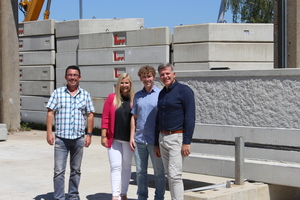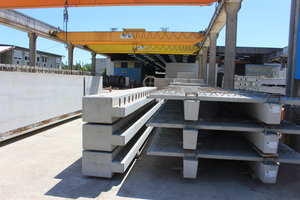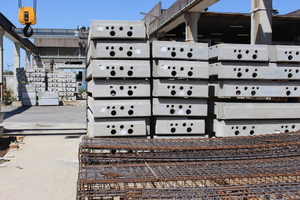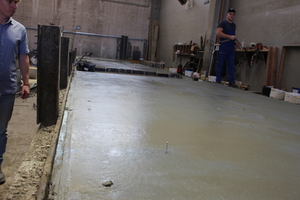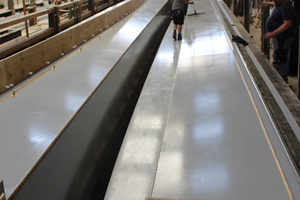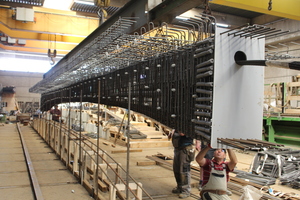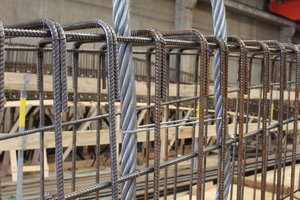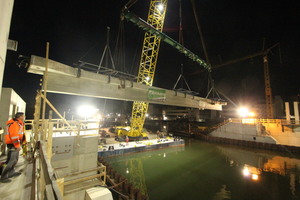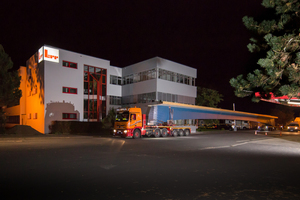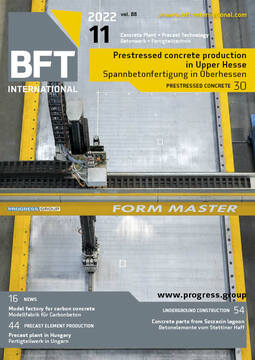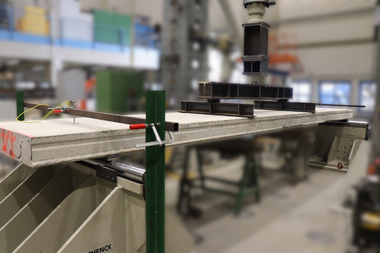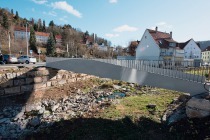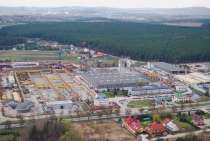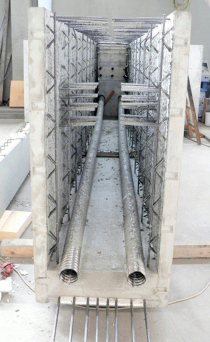State-of-the-art prestressed concrete
production in Nidda, Upper Hesse
Oberhessisches Spannbetonwerk GmbH was founded in 1965 and covers the entire range of precast structural components, that is, all structural components made of concrete for industrial, building and engineering construction. These include heavy bridge components of prestressed concrete and reinforced concrete, as well as all types of precast wall panels and beam elements.
Oberhessisches Spannbetonwerk GmbH, a company based in Nidda near Frankfurt am Main, was founded in 1965 by Karl-Ludwig Lupp as a subsidiary of the internationally active Lupp corporate group and covers the entire range of precast structural components, that is, all structural components made of concrete for industrial, building and engineering construction. The portfolio includes heavy bridge components of prestressed concrete and reinforced concrete, structures for building construction and non-standard designs, as well as all types of precast wall panels and beam elements. Concrete with strength values of up to C70/85 is produced in the company’s own mixing plant. The use of self-compacting concrete (SCC) is possible for special applications. This results in a comprehensive offer for customers, which is supported by the required certifications. OSW claims to be particularly efficient in the production of large-sized precast concrete elements weighing up to 105 tons and measuring up to 50 meters in length. These services are complemented by an intelligent time and cost management guaranteeing smooth processes and reliability.
The company has been offering an extensive product portfolio right from the beginning: in addition to wall elements with different types of surface finish, the production range included piles for driving, prestressed floor slabs and roof slabs, as well as prestressed precast components for bridges (Dendl system) including bridge caps. In the late 1960s, there was even a parking deck developed in-house; throughout the period until today, however, the focus is on bridge and commercial construction.
Oliver Rühr, managing director of OSW, explains: “One of our key strengths is that we can also manufacture more complex precast elements; the same applies to the weights and dimensions of individual components. In addition, there is the potential for larger bridge orders, such as two currently commissioned green bridges with 80 and 86 bridge girders of 65 tons each. For a request for quotation of 30 bridge girders with a length of around 35 m and a weight of approx. 90 tons, we had to evaluate once whether this volume can be stored in our crane runway, which would also definitely be possible. In addition to large projects like these as decisive sales drivers, there is currently a demand mainly for bar parts and trusses of all kinds. Overall, inquiries from the infrastructural sector are increasing.
In principle, there is a certain degree of security through the parent company Lupp, which repeatedly commissions OSW with commercial projects, high-rise projects or now again with precast elements for data centers, so that and through this, the expertise can also be further expanded. Nevertheless, we as OSW are responsible for a continuous capacity utilization of the plant and accordingly also conduct acquisition ourselves. Here we convince with very good specialists in the area of work preparation and production, some of whom have decades of experience. In the end, however, it is also about the entire team, in which everyone also brings an emotional attachment to the company.
Important process of modernization
“We are a small company but still very efficient and therefore able to solve more complex construction tasks. The regional connection to the Rhine-Main metropolitan region is not only interesting for our customers. With regard to infrastructural construction measures, it also opens up very good acquisition opportunities for us in this catchment area; it is therefore an important success factor. The fact that we are also absolutely competitive as a small manufacturer is reflected in our market-oriented pricing and technical know-how. All of this is complemented by the often very close project support provided by our staff, which, in addition to product quality, leads to a high level of customer satisfaction,” continues Oliver Rühr.
OSW is currently undergoing a modernization process that covers all company areas. The main items include:
structural modernization and expansion of the factory buildings: in addition to necessary renovation measures, production processes are to be improved and weather-independent storage areas are to be created
reduction of fossil energy demand in production, installation of a photovoltaic system on all of the building roofs including storage facilities, and conversion of the previously gas-powered formwork heating system to electrical operation
replacement of the concrete recycling plant
integration of a CRM system to improve the coordination of customer relations and the entire project flow and to provide support for potential analyses
additional staff for costing/process planning and warehouse/loading; training of civil engineers via a dual course of study.
Managing director Oliver Rühr comments: “In the near future, after completion of the modernization measures, I would like to have an Environmental Product Declaration created for our products in order to derive potentials for further optimization from the EPD. In this context, the developments in binding agents and concrete reinforcement will certainly also play a decisive role. The previous consideration can certainly also be linked to the topic of a building cadaster; we generate the necessary component information automatically when costing our products.”
Precast element embedded in the Neckar river according to plan
When asked about particularly impressive reference projects, Project Manager Christian Heins reports: “Just recently, we delivered a 37-m long prestressed concrete component for a flood gate that is intended to protect several Neckar riparian municipalities in the vicinity of Mannheim from flooding.”
The Ladenburg flood gate closes off the lateral canal between Ladenburg and Mannheim-Feudenheim in the event of a flood. In order to avoid a construction method with a dry excavation pit and, in this respect, long half-sided disruptions to shipping, a prestressed concrete prefabricated pile with a weight of 140 t, a length of 37 m, a height of 2 m and (as a slab beam) a width of 2.60 m is being used. After installation at the final depth, the precast element will be secured in place in the riverbed by means of underwater concrete.
The precast element will be transported to the port of Ladenburg on SPMTs, where it will be lifted by a Hebo 8, the largest floating crane available. Suspended from the crane, the precast element will be shipped to the construction site and lowered into the excavation pit. The entire installation process will be supported using surveying technology. The tolerance during installation will remain below the specified values of +/-10 mm. The excavation pits for the lateral abutments will be backfilled after installation in order to connect the precast element with conduits to the abutment.
Other – no less impressive – examples of projects include the Partially prestressed beams for the 190-m high Omniturm skyscraper in the City of Frankfurt, the FRA 10 computer center (also in Frankfurt) and the Danone Nutribition in Fulda, as well as road bridges crossing the A3 motorway near Heusenstamm and Marktheidenfeld, the A7 motorway near Petersberg, and the B429 federal road near Gießen; furthermore, a railway bridge near Breitengüßbach, a pedestrian bridge near Kirchen, and a green bridge crossing the A61 motorway near Kerpen.
Well-positioned in the medium and long term
In addition to strong customer loyalty, OSW attaches great importance to a long-standing relationship of trust with its suppliers. From the production facilities, such as formwork and tilting tables from Avermann, via the prestressing technology supplied by Paul and the transport anchors from Philipp, the manufacturer also maintains good relations of partnership with its suppliers of cement and concrete chemistry (Schwenk and FuchsLubritech, respectively).
“Despite a general downturn in the construction industry, I still see very good development opportunities for us as OSW,” concludes Oliver Rühr. “We are broadly positioned, work in building construction as well as bridge construction, and can solve complex construction tasks at any time. I assume that the proportion of prefabricated construction products will tend to increase in the future as a result of the shortage of skilled workers. Reinforced concrete and prestressed concrete prefabricated parts are therefore definitely irreplaceable for the time being, even taking into account all sustainability considerations. There will have to be a development in terms of CO2 or resource efficiency; however, this does not change the fundamental nature of our business.
With regard to an expansion of our activities, there are various models; the question is whether we want to use the existing space to increase our own capacities or alternatively involve partners that are interested in participating in our expertise and in the advantages offered by our location – we are always open to attractive offers. This means that there is considerable future potential at the Nidda location, and our employees are ready to take advantage of this opportunity!”
CONTACT
Oberhessisches Spannbetonwerk GmbH
Alois-Thums-Straße 1-3
63667 Nidda/Germany
+49 6043 807 106

